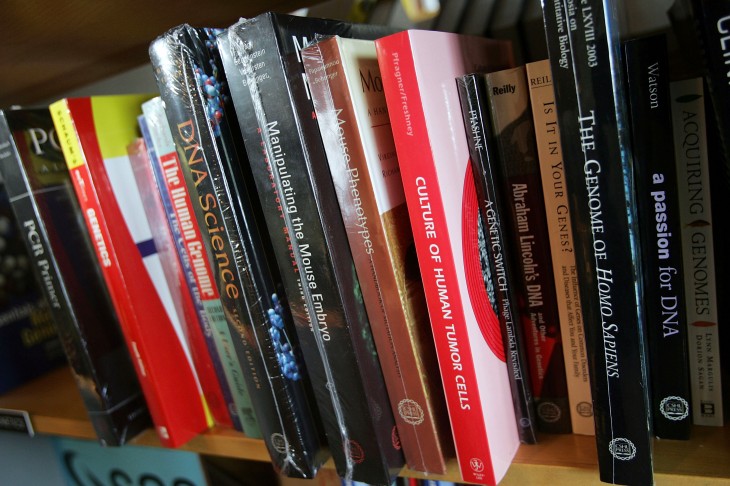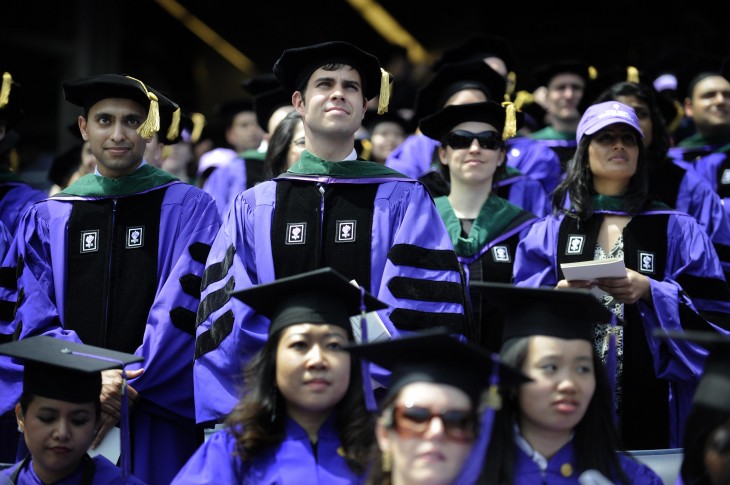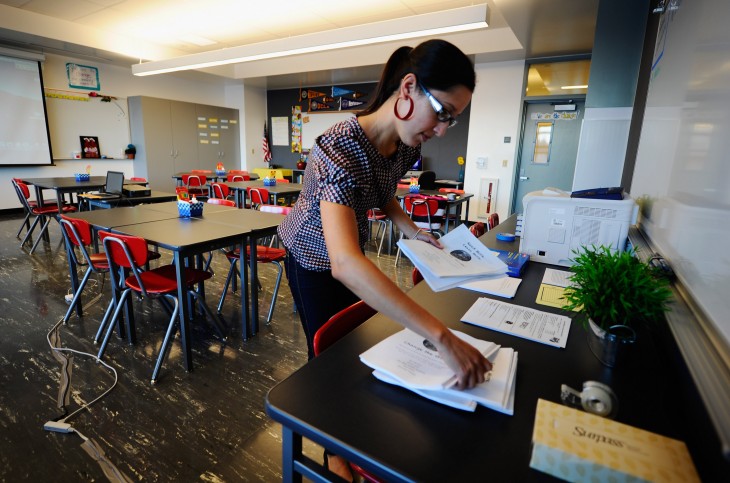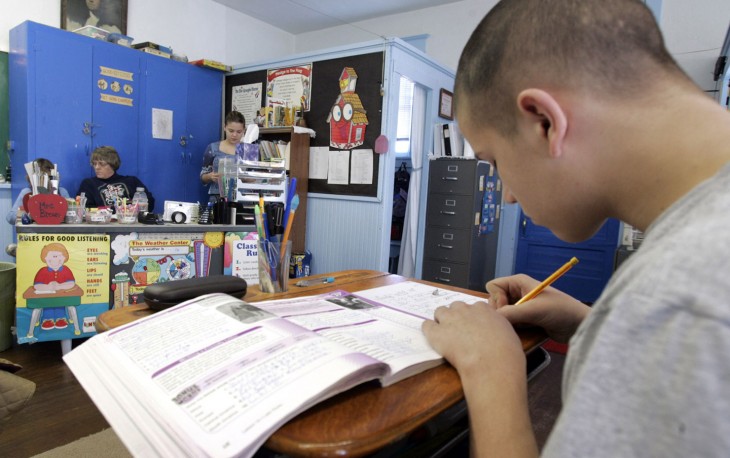
In 2010, a movie came out in theaters that highlighted a growing problem in our education system: that students are finding it more challenging to get a quality education based on the current paradigm. Waiting for ‘Superman’ is certainly a powerful film and follows several students striving to go to a charter school in pursuit of better learning.
While the film raised controversial issues, a thought came to me: students are being distracted by the problems that have become endemic to the current education system and are struggling to learn. So in light of this, could technology step in to complement what they’re being taught and better prepare them for the working world and life?
Is the education technology sector ‘Superman’?
Dealing with lack of support
In the United States, schools that teach students from kindergarten to high school seniors have run into resource issues. Why? It’s due to the global recession and budget cuts that states have habitually made towards education. When I was in public school, I remember the district often holding referendums to help raise money to support its schools.
With fewer resources available to them, that means more students per classroom and a decrease in available courses, leading some to abandon the system and go after private and charter schools, where competition for admission is fierce. Without the tools and solutions available to students, how can they gain the knowledge to figure out what they want to do when they graduate (or rather if they do)?
Today, the system appears to be in major flux with the 5 percent automatic across-the-board cuts being made due to the enactment of the sequestration cuts, reducing the funding for the US Department of Education programs by $2.5 billion.
There’s a bevy of startups in this space that are looking to help students, parents, teachers, and also school districts combat this dilemma. And so while the community is battling with its local government for funding, it appears tech companies are leveraging their know-how to keep the train going, so to speak.
‘Commercialization’ of the classroom?
The adoption of technology in the classroom isn’t a new thing — it’s already being used in practically all schools (hello, Internet?), but there are other services that will help augment what they’re learning in class, potentially helping bolster a student’s academic performance. In a way, it’s akin to the commercialization of the classroom — are tech companies looking to help students learn on devices that they’re already familiar with?
I remember when I was in school, one of the popular education services used was Blackboard, a virtual learning environment and course management system. Back in the late 1990s, education technology startups like Coursera and Khan Academy didn’t exist. If you needed help outside of the classroom, you went to your teacher, a tutor, or companies like Kaplan and Kumon. More than a decade after its founding, Blackboard wound up getting acquired for $1.64 billion from an investment group led by Providence Equity Partners.
In a study recently published by OnlineColleges.net, a vast majority of students are already proficient in using phones, text messages, social media, and the like. Here’s some of its findings:
- 93 percent of students who own phones use them to send text messages
- 3D printers are becoming more popular in education environments
- eBooks continue to replace traditional textbooks
- Video game-based learning is becoming continuously more effective
- Educational institutions are continuing to adopt cloud-based technologies
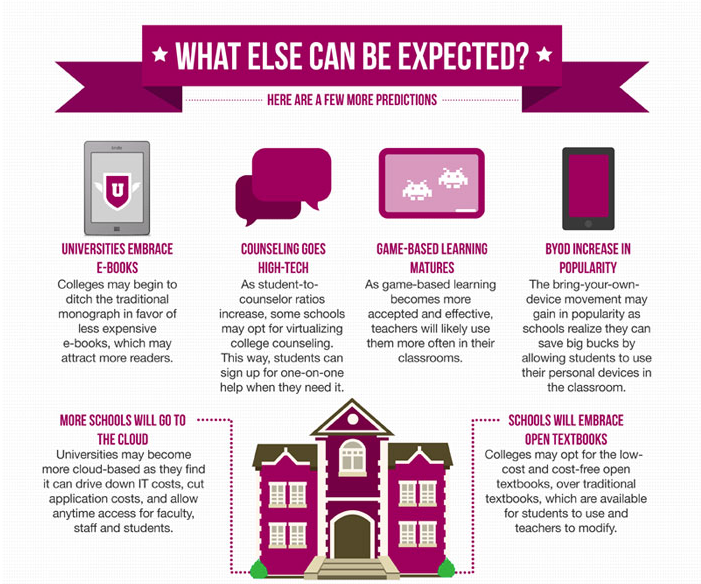
Schools are already providing laptops and tablet devices to their students at the beginning the academic year, seemingly to replace the need to carry around heavy textbooks and saving everyone a lot of money. But it’s not a foolproof plan as there are critics that suggest it will do little to encourage students to read (studies show that they don’t).
Helping everyone, both in and out of the classroom
The education technology space is certainly a hot market and there are perhaps hundreds of companies all vying to be appealing to teachers/professors, parents, students, and administrators. Some are well-known, including Edmodo, Chegg, Treehouse, PluralSight, Amplify, ShowMe, Subtext, and The Minerva Project, but there are many more that are striving to help change the world.
We’re all aware of the success companies like Coursera, Khan Academy, Codecademy and Udemy have had when it comes to helping educate people outside of the classroom, but what about those services seeking to help inside? An example is CK-12 Foundation, a California-based non-profit organization started by Neeru Khosla, wife of Sun Microsystem co-founder and venture capitalist Vinod Khosla.
As with all ed-tech companies, CK-12’s philosophy is to look at what’s wrong with education. It fundamentally believes that solutions must tackle the root of the problem, not the place that the problem starts manifesting itself. The organization is targeting those from kindergarten to 12th grade and looking to help provide students and teachers with textbooks and learning resources that it hopes will actually work.
We sat down with Khosla and her team and found out that the average cycle for a text book is seven years so by the time students matriculate out of their current school, they’ll have left with outdated information. Using its service, teachers and students can craft their own textbook using the latest information. Through its software, CK-12 has academic scholars and experts develop textbooks that teachers can use in their courses.
Khosla tells us that teaching doesn’t have to be just from textbooks, but multiple modalities, such as videos, software, and more. In its current form, students and teachers are both served, with students able to get additional assistance through a tutorial website that will guide them through problems in mathematics, science, english, and other subjects.
Teachers can look through textbooks and make copies of the relevant lessons they want — the organization looks at the teaching requirements from all 50 states in the US. CK-12 says that it has broken each lesson into bite-size nuggets of information, which should help improve student comprehension of the subject.
In February, CK-12 launched a student competition called “Get Real” to encourage students to develop a real-world application of a science, technology, engineering, and mathematics (STEM) concept they’ve learned.
Other startups looking to help the academic world include Clever, which is looking to help teachers better perform and improve access to data to share with their students. A Y Combinator company, it has partnered with 40 of the leading companies in the K-12 space such as DreamBox, Scientific Learning, and MasteryConnect. In doing so, it creates a centralized database between a school’s SIS database and the startup’s partners.
So far, Clever has more than 2,000 schools integrated with its service, allowing teachers to pull lessons from its partners and have students complete the exercises in the classroom. When graded, those records would be passed through Clever and stored in the school’s SIS database. Adding new apps to the system is reportedly easy to do as well, requiring only five minutes.
We mustn’t forget about the work done by companies to help foster education in much needed parts of the world, like what Google has done with its Apps platform, Chromebook, and other product initiatives. Some of its successes include having 2,000 schools signed up to use its hardware, launching Google Play for Education to make it easier for young children to find age-appropriate apps to bolster their learning, creating a Search Education site for teachers to assist in the development of lesson plans and classroom activities, and more.
YouTube is also playing a pivotal role in how educators are supplementing their teachings in the classroom. During World Teachers’ Day in 2012, the company revealed that more than 1,000 educational channels were featured on the video sharing website, making it possible for anyone to continue learning both in and out of the school setting.
Apple is most certainly also involved in the education space — for decades, it has been in a close relationship with the academic world –practically every school in the US had Apple computers in them. Now, with the iPad tablet device, it’s taking on the textbook, similar to what CK-12 is doing, and hopes that students will find it appealing enough to want to study more.
At an education event in January 2012, the company debuted iBooks 2, which was called the “new textbook experience for the iPad.” As we all know, textbooks are expensive, physically cumbersome, and prone to being obsolete in a year or so. But with digital copies, educators can have better up-to-date versions instantly without needing students to get new books.
Putting it all to the test
It appears that startups are certainly gaining recognition in the community and on their way to becoming as successful as Blackboard. Last month, the online book rental service-turned digital hub for students Chegg announced it is going public with an intent to raise $150 million in capital.
Udacity is another service receiving some noteworthy attention. It is in a relationship with San Jose State University to test out use of the platform’s online courses as part of its curriculum. After the first semester was a disappointment, the university saw a marked improvement in four of the five summer courses it offered, showing some potential.
And while there’s certainly more cases of education technology startups receiving press accolades or hitting other milestones, the point here is that many of these services are getting noticed by the academic world and are becoming seen as important to helping reform the broken system. As serial entrepreneur Naveen Jain, founder of Moon Ex and a trustee board member at X Prize and Singularity University, penned in a Forbes article:
Rethinking education starts with embracing our individuality. Our life experiences are very different from one and other, and yet we seem to think every one of us can learn the same way. Some of us learn experientially, while others are more attracted to logical or conceptual learning. Why are we limiting ourselves to one format or curriculum when we know that each individual is going to learn differently?
Don’t abandon your teachers — technology isn’t taking over
But while startups are doing what reformers hoped would be done by our leaders, what do governments think about these initiatives? Will it help improve the education system? US Secretary of Education Arne Duncan addressed this issue during a Google+ Hangout in August during an interview with Khan Academy founder Sal Kahn.
During the 36 minute conversation, Secretary Duncan responded to a question about the use of technology in the classroom, specifically in terms of reducing the amount of human interaction between students and teachers:
Technology is never going to replace great teachers. What all the research and studies seem to show is that blended learning, great teachers empowered by great technology is what’s leading to the best educational outcomes and achievements for students…
I think technology can help to strengthen teaching, help teachers not just teach, but actually know whether their students are learning or not. The goal is not to teach, the goal is to actually have students learn, to have students much more engaged in their own learning, to have parents know what’s working and what’s not and have them be better partners. There’s tremendous upside.
Secretary Duncan says that he’s optimistic about the use of technology and its future in the education space. And already, the Department of Education is doing something to back up those feelings. Starting with the 2014-2015 school year, schools will need to comply with the Common Core State Standards program, which has been adopted by 45 states and the District of Columbia.
What is the Common Core State Standards program? It’s perhaps the first of its kind that enables states to collaborate on a range of tools and policies, including the development of textbooks, digital media, and other teaching material. In addition, it enables the creation of a “common comprehensive assessment system” that will measure student performance annually. So starting next school year, schools will need to invest in education technology services lest students be left behind.
Juan Lopez-Valcarcel, Chief Digital Officer at education and publishing company Pearson, agrees with Duncan. At TNW’s conference in Amsterdam this year, he spoke about the ed-tech space, which he says is a $4 trillion market — three times larger than the mobile space, and eight times larger than the advertising industry. His entire talk is below:
Technology isn’t education reform’s silver bullet
Now, some of you might be reading this thinking that I’m claiming that technology is the end all be all cure for all that ails the education world. This is not what I’m saying — it is part of the solution.
Communities and governments need to figure out ways to help support schools and improve student performance so that they can do well in their future professional endeavors. And while that might include budget constraints, resource deficiencies, overcrowding in the schools, lack of qualified teachers, and a slew of other issues constantly raised, learning shouldn’t have to suffer.
So while the physical classroom may be going through some seemingly never-ending turmoil, perhaps technology can offer a helping hand and be that one party that actually thinks about the children.
Now read:
- How the Internet is Revolutionizing Education
- Stay in or drop out? The entrepreneur’s education fiasco
Photo credits: BORYANA KATSAROVA/AFP/Getty Images, Mark Dadswell/Getty Images, Michael Nagle/Getty Images, infographic from OnlineColleges.net via AnsonAlex.com, Joe Raedle/Getty Images, EMMANUEL DUNAND/AFP/Getty Images, Chung Sung-Jun/Getty Images, Kevork Djansezian/Getty Images, and Larry W. Smith/Getty Images
Get the TNW newsletter
Get the most important tech news in your inbox each week.


